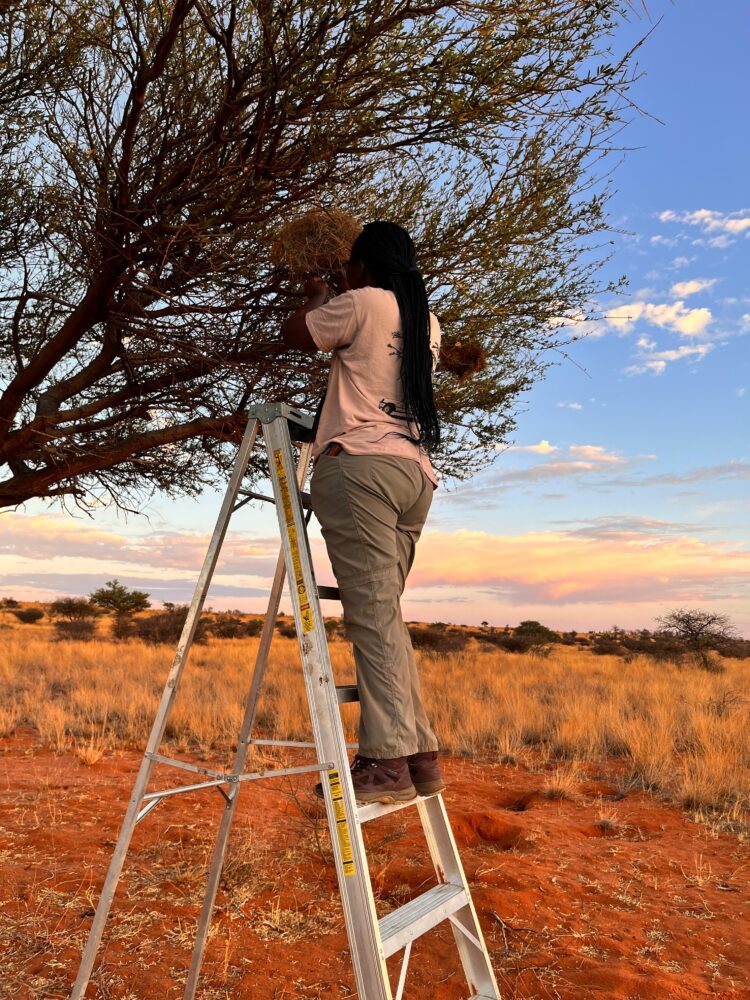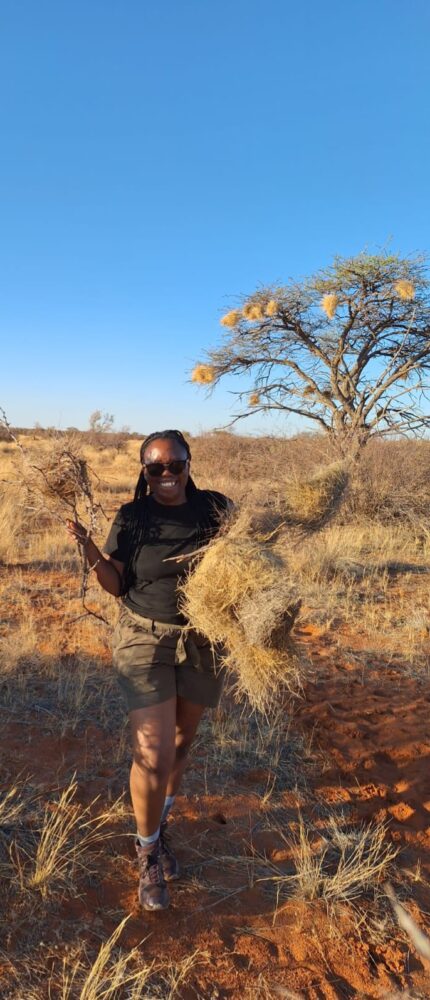Photo by Lesedi Moagi
Conducting fieldwork under the blistering 40ºC heat of the southern Kalahari, Lesedi Moagi had to time her outings to align with the activity of her research subjects — white-browed sparrow-weavers.
“Some mornings, by 7.30am, it was already over 20ºC,” recalled Moagi, a master’s student at the University of Cape Town. “And the birds were already becoming less active. They have to split their daily activities depending on the temperature.”
Moagi’s research focused on understanding how the untidy yet intricate nest structures built by the sparrow-weavers, which live in cooperative family colonies of up to 14 birds, serve as a resource for other bird species in the semi-arid wilderness of the Tswalu Kalahari Reserve.
“We already knew that birds like scaly-feathered weavers, ashy tits and the Acacia pied barbet were roosting in these nests,” she said, noting this behaviour hadn’t been studied in detail.
The inspiration for the research came from another desert species — the sociable weaver — whose apartment-block-like communal nests are used by a variety of species. That research is well-established, Moagi said.
“With white-browed sparrow-weavers, their nests are also being used by other bird species but this has not been studied deeply and it hasn’t been understood as well. That’s how the idea came about — that it would be cool to actually try to understand the value that these nests hold in the ecosystem.”
 (Photo by Azraa Ebrahim)
(Photo by Azraa Ebrahim)
To assess the effect of the sparrow-weaver’s nest structures, she observed both naturally occurring nests and those that had fallen in the wind, which she relocated to trees without nests. She then compared bird abundance and species diversity in areas with and without nests.
“We wanted to see if they also affect the overall avian community in the Kalahari to see in an area with more of these nests,” she said. “We wanted to measure the avian abundance and the number of species that are actually hanging around these nests. We saw their numbers increasing.”
Her findings position the sparrow-weavers as ecosystem engineers — species that modify the environment in ways that benefit other organisms. But the sparrow-weaver population itself may be under threat.
Once common across the Kalahari, their numbers are declining in some areas. The causes are still unclear and could be linked to changes in rainfall patterns, food availability or habitat changes and need further study, she said.
Moagi said fewer sparrow-weavers could mean fewer shelters, which might force other species to expend more energy building their own, or even struggle to survive.
“The physical changes the sparrow-weavers make influence the distribution of the animals. If we have less of these sparrow-weavers, it might affect the number of the species that are using these structures; it might influence their distribution and their movement.”
 (Photo by Sthabile Khumalo)
(Photo by Sthabile Khumalo)
The ability to find safe, insulated shelter is critical for survival in the harsh Kalahari environment. “The Kalahari is so hot. Birds can’t finish building a nest in a single day because it gets so hot and they need to conserve their energy.”
Moagi also placed temperature loggers inside and outside the nests to measure their insulation. The results showed that the nests provided a consistent buffer against extreme temperatures — up to a 4ºC difference compared to the surrounding air.
In the Kalahari, that kind of thermal stability is crucial.
With climate change making the Kalahari hotter and drier, such shelter could become even more vital for desert-adapted birds. Protecting the sparrow-weaver and its nesting habitat is crucial, Moagi said, not just for the species itself, but for the broader bird community.
She suggested practical interventions including providing water points and shaded areas in key nesting zones and preserving grasses used in nest-building.